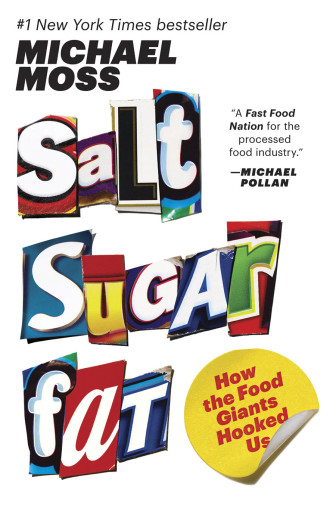 Salt Sugar Fat: How the Food Giants Hooked Us
Salt Sugar Fat: How the Food Giants Hooked Us
Michael Moss
Random House, 2013
447 pages
In writing “Salt Sugar Fat: How the Food Giants Hooked Us,” Michael Moss, a New York Times reporter, and recipient of the 2010 Pulitzer for explanatory reporting, tells the inside stories about how food giants and their processed foods attract and keep consumers — especially young people.
Moss interviewed executives and met with scientists who walked him through development of complex formulations to reach a food’s “bliss point,” that most flavorful convergence of salt, sugar, fat and artificial flavorings that leaves us craving more — there is chemistry behind Lay’s potato chips hugely memorable jingle, “Betcha can’t eat just one.” Chips and cookies and other enticing snacks are created so that eating just one is highly unlikely, and the beneficiaries are the food giants who have spent millions jockeying for space on grocery store shelves to ensure the bottom line and greater market share. The losers are children and young adults who regularly eat processed foods that do not provide the nutrients growing bodies need.
Moss’ book about the smoke and mirrors of processed foods, and the ingredients contributing to obesity, diabetes and high blood pressure, is riveting on many levels. It is a captivating account of an industry that started with convenience foods but which now provides staple foods for many Americans who have no idea of the amount of salt, sugar and fat contained in these tasty formulations. Moss writes as a detective unlocking the secrets to the most beloved products such as cheese, Oreo cookies and soda — it is a peek that will likely change purchasing and eating habits and cause youth workers to reconsider choices for celebrations and after-school events.
It is eye-opening to learn how food companies will do almost anything to win consumers’ loyalty — and dollars. It is shocking how these companies oppose efforts by consumer groups and the U.S. government to be upfront about their ingredients and the processes by which they are made, and it is shameful that the “biggest government watchdogs show no teeth when it comes to controlling the industry’s excesses in promoting sugary, high-calorie fare.”
Lastly, it is reprehensible that these companies knowingly target children and young adults, and poor people, to hook them on salt, sugar and fat that are addictive — research that Moss lays out in this book. Moss shows how many of these food giants’ products make their way into schools through the U.S. Department of Agriculture’s food program, although most food executives do not eat processed foods.
Moss is a master storyteller, and this story is equal parts human biology, chemistry, marketing, and manufacturing — each essential to understanding the transformation of American’s palates and waistlines by processed foods. The book is organized into three parts: sugar, salt and fat. In each, Moss describes the chemistry of sugar, salt and fat and ways the food industry’s tweaking results in products with flavorful taste but few nutrients.
Moss’ explanations of what these ingredients do to the human body are fascinating. The books opens with a prologue, “The Company Jewels,” in which Moss begins to weave this detailed and well-researched tale by recounting a secret April 1999 meeting convened by James Behnke, a top official at Pillsbury, to persuade other CEOs that their high-calorie foods were responsible for a growing health crisis, a crisis that needed to be managed before the government stepped in, or the consumer balked. The book’s backmatter includes an epilogue, a note on sources, a selected bibliography and an index.
“Salt Sugar Fat” has been translated into 18 languages and was summer reading for incoming freshman to Virginia Commonwealth University. This book would make a wonderful chemistry, business, psychology or sociology text for high schoolers and college students to learn the science of food and to understand how quickly these products have changed American society — even to the extent that the United States military has a difficult time finding recruits because so many young people are obese and do not fall within their weight guidelines.
On his website, Moss suggests ways to fix this processed-food problem and to navigate grocery store aisles so that one’s cart doesn’t fill with high-calorie but low-nutrient foods.
This book has the potential for changing the way anyone looks at food or makes food purchases. It is a powerful book for parents and teachers to help children understand how candy, soda, chips and other processed foods come at a cost: lots of sugar, fat and salt that are increasingly blamed for America’s health challenges.
Additional resources about processed food, nutrition
The nutritional value of school lunches must be a concern as educators and youth workers observe increases in obesity and other health challenges.
Some online resources include:
- National Public Radio’s articles about school lunch.
- Lucy Komisar’s New York Times op-ed piece, “How the Food Industry Eats Your Kid’s Lunch,” describes the failures of the National School Lunch Program. The many references in this online article provide youth workers additional opportunities to delve deeper into this situation and develop policies for their organizations.
- Nicholas Confessore’s New York Times article, “How School Lunch Became the Latest Political Battleground,” is about recent changes to the federal school-lunch program and how this program has contributed to childhood obesity.
- Self Nutrition Data: Know What You Eat provides consumers with a primer to read and understand nutrition labels, which Moss considers essential to controlling one’s diet. (NutritionData is published by Condé Nast Publications, and the information in its database comes from the USDA’s National Nutrient Database for Standard Reference.)
























